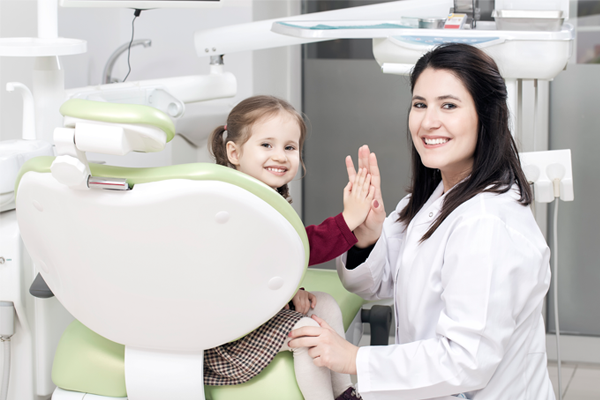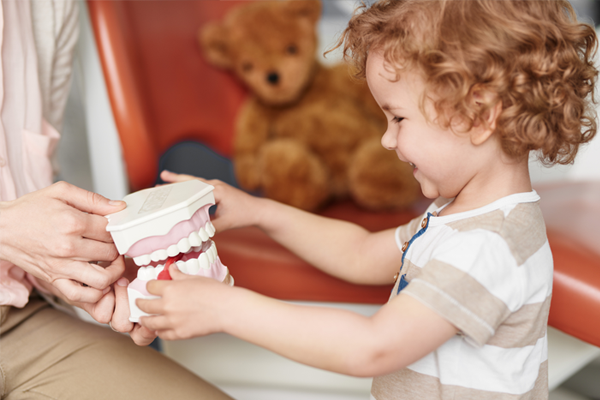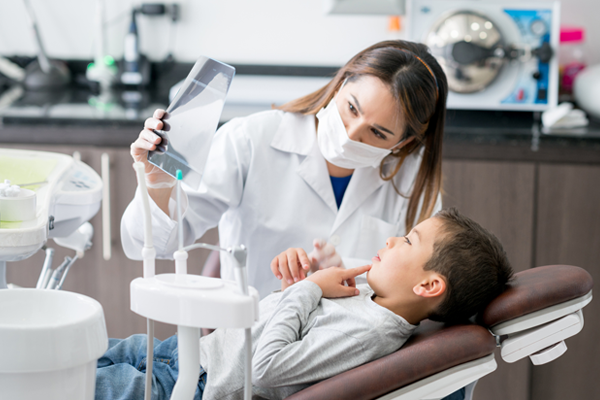About Pediatric Dentistry
A child’s first visit to the dentist should be enjoyable. Children are not born with a natural fear of the dentist, but they can fear the unknown. Our office makes a special effort to use pleasant, non-frightening, simple words to describe each treatment. We want you and your child to feel at ease from the moment your family arrives at our office. The more you and your child know about the first visit, the better you will feel.
The American Academy of Pediatric Dentistry recommends…

Children should visit the dentist by their first birthday. It is important that your child’s newly-erupted teeth (erupting at six and 12 months of age) receive proper dental care and benefit from proper oral hygiene habits right from the beginning.


When New Teeth Arrive

Your child’s first primary or baby teeth will begin to erupt between the ages of six and 12 months, and will continue to erupt until about age three. During this time, your child’s gums may feel tender and sore. To help alleviate this discomfort, we recommend that you soothe the gums by rubbing a clean finger or a cool, wet cloth across them. You may also choose to make use of a teething ring. When your child has finished teething, you can expect a total of 20 primary teeth.
Your child’s primary teeth are shed at various times throughout childhood, and their permanent teeth begin erupting at age six, and continue until age 21. Adults have 28 permanent teeth, 32 including wisdom teeth.
Adopting Healthy Oral Hygiene Habits

As your child’s teeth erupt, be sure to examine them every two weeks, looking for lines and discoloration that may be caused by decay. Remember that sugary foods and liquids can attack a new tooth, so take care that your child brushes after feeding or eating. We recommend brushing four times a day for optimal oral hygiene: after breakfast, after lunch, after dinner, and at bedtime.
Brushing can be fun, and your child should brush as soon as the first tooth arrives. When a baby’s tooth erupts, parents should brush the tooth with a soft-bristled toothbrush and a pea-sized amount of toothpaste. For children younger than two, do not use fluoride toothpaste unless advised to do so by your dentist or other healthcare professional. We suggest reviewing proper tooth brushing procedures with your child.
Flossing is also a part of good oral hygiene habits, and your doctor will discuss with you the right time to start flossing. If you notice signs of decay, contact your dentist immediately.


Preventing Tooth Decay with Regular Checkups

Tooth decay is caused by sugars left in your mouth that turn into an acid, which can break down your teeth. Children are at high risk for tooth decay for a simple reason; many children and adolescents do not practice regular, good oral hygiene habits. Proper brushing and flossing routines combined with regular dental visits help keep tooth decay away.
Your child should visit the dentist every six months for regular dental cleanings and checkups. We recommend fluoride treatments twice a year along with cleanings to keep teeth their strongest. Tooth sealants are also recommended because they “seal” the deep grooves in your child’s teeth, preventing decay from forming in these hard-to-reach areas. Sealants last for several years, but will be monitored at your child’s regular checkups.
Children’s Dentistry

Georgian Dental invites you to take an introductory tour of our facility. On this day, touring junior visitors and their parents meet Dr. Tan and Dr. Crosby, practitioners with warm personalities and reassuring approaches which make every visit relaxing, comfortable and fun. Introducing children to the world of dentistry in an enjoyable environment creates a positive attitude towards oral health and creates an eager office and home care participant!


Pit & Fissure Sealants

Georgian Dental utilizes sealants. Sealants are a protective barrier bonded to the chewing surface of a tooth. It prevents bacteria from accumulating into tiny grooves on the surfaces of the teeth. This does not eliminate the need for proper dental care but is recognized as an effective and valuable asset in the prevention of tooth decay. The application of sealants does not require anesthetic or drilling of the tooth.
